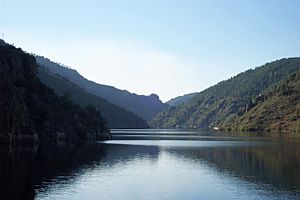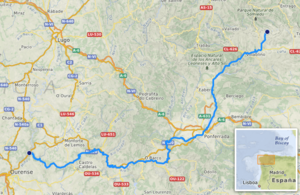Sil (river) facts for kids
Quick facts for kids Sil |
|
|---|---|

The Sil Canyon as seen from the river
|
|

Path of the Sil
|
|
| Native name | Río Sil (Spanish) |
| Country | Spain |
| Autonomous Community | Castilla y Leon, Galicia |
| City | Ponferrada |
| Physical characteristics | |
| Main source | Villablino León, Castilla y León, Spain 43°01′54″N 6°09′19″W / 43.031615°N 6.155348°W |
| River mouth | Miño Estuary Atlantic Ocean, Spain 0 m (0 ft) |
| Length | 228 km (142 mi) |
| Basin features | |
| Progression | Minho→ Atlantic Ocean |
| Tributaries |
|
| Reservoirs | Las Rozas, Bárcena, Peñarrubia, Pumares, Santiago, San Martiño, Sequeiros, Santo Estevo, San Pedro ou Pombeiros |
The Sil is an important river in Spain. It flows through the regions of Castile and León and Galicia. The Sil is a major branch of the Miño River.
The Sil River is about 225 kilometres (140 mi) long. It starts in the Cantabrian Mountains near the town of Villablino. The river then flows through the provinces of León and Ourense. The biggest city along the Sil is Ponferrada. The Sil joins the Miño River before the city of Ourense.
Contents
Where the Sil River Meets the Miño
The Sil River joins the Miño River in a place called Os Peares. This area is in the Province of Ourense.
Usually, rivers are ranked by how much water they carry and how long they are. The Sil River actually carries more water than the Miño River where they meet. It is also about 20 kilometres (12 mi) longer than the Miño at their meeting point.
There is a famous saying in Spanish about this: "El Miño lleva la fama y el Sil le da el agua." This means, "The Miño gets the fame, but the Sil gives it the water."
Journey of the Sil River
The Sil River travels through many areas in León and Ourense. In León, it passes through places like Babia, Laciana, El Bierzo, and La Cabrera. In Ourense, it flows through Valdeorras.
Some of the towns and cities the Sil River flows near include:
- Villablino
- Ponferrada
- O Barco de Valdeorras
- A Rúa
- Quiroga
- Ribas de Sil
Rivers Joining the Sil
Many smaller rivers flow into the Sil River. These are called tributaries.
- Rivers joining from the left side:
- Valseco
- Boeza
- Oza
- Cabrera
- Bibei
- Navea
- Mao
- Rivers joining from the right side:
- Caboalles
- Valdeprado
- Barredos
- Cúa
- Burbia
- Selmo
- Soldón
- Lor
- Cabe
Gold in the Sil River
The Sil River has been a great source of alluvial gold for a very long time. Alluvial gold is gold found in riverbeds. The most gold was collected during the time of the Romans. This happened after the Roman emperor Augustus took control of northwest Spain in 25 BC.
The upper parts of the river had large amounts of gold. The area around Las Médulas was especially rich in gold. The Romans used a method called hydraulic mining to get the gold. This involved building many aqueducts (water channels) to bring water. They used the water to wash away the soil and rocks to find the gold.
What the Name "Sil" Means
Experts believe the name "Sil" comes from a very old European word. It might come from an ancient word that means "drip," "run," or "humid."
See also
 In Spanish: Río Sil para niños
In Spanish: Río Sil para niños
- List of rivers of Spain
- Rivers of Galicia


